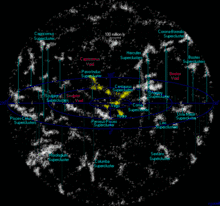Laniakea Supercluster
The Local Supercluster, Local SCl, or Laniakea Supercluster (Laniakea, Hawaiian for open skies or immense heaven),[2] is the galaxy supercluster that is home to the Milky Way and approximately 100,000 other nearby galaxies. It was defined in September 2014, when a group of astronomers including R. Brent Tully of the University of Hawaii, Hélène Courtois of the University of Lyon, Yehuda Hoffman of the Hebrew University of Jerusalem, and Daniel Pomarède of CEA Université Paris-Saclay published a new way of defining superclusters according to the relative velocities of galaxies. The new definition of the local supercluster subsumes the prior defined local supercluster, the Virgo Supercluster, as an appendage.[3][4][5][6][7]
| Laniakea Supercluster | |
|---|---|
.png) Map of the Laniakea Supercluster and its component galaxy clusters | |
| Observation data (Epoch J2000) | |
| Constellation(s) | Triangulum Australe and Norma (centre) |
| Right ascension | 10h 32m |
| Declination | −46° 00′ (Great Attractor) |
| Brightest member | Milky Way (mag –5.0) |
| Number of galaxies | 100000–150000 |
| Major axis | 520×106 ly (159 Mpc) h−1 0.6780 ± 0.077 (Hubble constant based on Planck data) |
| Redshift | 0.0708 (center) |
| Distance (co-moving) | 250×106 ly (77 Mpc) h−1 0.6780 ± 0.077 (centre) (Hubble constant based on Planck data) |
| Binding mass | 1×1017[1] M☉ |
| Other designations | |
| Local Supercluster, Laniakea, Laniakea Supercluster, Laniakea Complex | |

Follow-up studies suggest that the Local Supercluster is not gravitationally bound; it will disperse rather than continue to maintain itself as an overdensity relative to surrounding areas.[8]
Name
The alternative name laniakea means 'immense heaven' in Hawaiian, from lani, meaning 'heaven', and ākea, meaning 'spacious, immeasurable'. The name was suggested by Nawa'a Napoleon, an associate professor of Hawaiian language at Kapiolani Community College. The name honors Polynesian navigators, who used knowledge of the heavens to navigate the Pacific Ocean.
Characteristics
The Local Supercluster encompasses approximately 100,000 galaxies stretched out over 160 megaparsecs (520 million light-years). It has the approximate mass of 1017 solar masses, or a hundred thousand times that of our galaxy, which is almost the same as that of the Horologium Supercluster. It consists of four subparts, which were known previously as separate superclusters:
- Virgo Supercluster, the part in which the Milky Way resides.
- Hydra-Centaurus Supercluster
- the Great Attractor, Laniakea's central gravitational point near Norma
- Antlia Wall, known as Hydra Supercluster
- Centaurus Supercluster
- Pavo-Indus Supercluster
- Southern Supercluster, including Fornax Cluster (S373), Dorado and Eridanus clouds
The most massive galaxy clusters of the Local Supercluster are Virgo, Hydra, Centaurus, Abell 3565, Abell 3574, Abell 3521, Fornax, Eridanus and Norma. The entire supercluster consists of approximately 300 to 500 known galaxy clusters and groups. The real number may be much larger because some of these are traversing the Zone of Avoidance, making them essentially undetectable.
Superclusters are some of the universe's largest structures and have boundaries that are difficult to define, especially from the inside. The team used radio telescopes to map the motions of a large collection of local galaxies. Within a given supercluster, most galaxy motions will be directed inward, toward the center of mass. In the case of Laniakea, this gravitational focal point is called the Great Attractor, and influences the motions of the Local Group of galaxies, where the Milky Way galaxy resides, and all others throughout the supercluster. Unlike its constituent clusters, Laniakea is not gravitationally bound and is projected to be torn apart by dark energy.[5]
South African astronomer Tony Fairall stated in 1988 that redshifts suggested that the Virgo and Hydra-Centaurus Superclusters may be connected.[9]
Location
The neighboring superclusters to the Local Supercluster are the Shapley Supercluster, Hercules Supercluster, Coma Supercluster and Perseus-Pisces Supercluster, they are all part of the composition of the Pisces-Cetus Supercluster Complex. The edges of the superclusters and Laniakea were not clearly known at the time of Laniakea's definition.[4]
See also
- Dipole repeller
- Galaxy cluster
- Galaxy filament
- Illustris project
- Local Void – nearest neighboring void
- Supercluster
- Void (astronomy)
- Walls (astronomy)
References
- "The Milky Way's 'City' Just Got a New Name". CityLab. 3 September 2014. Retrieved 9 September 2014.
- Taylor, Charles (2014). Science Encyclopedia. Kingfisher.
- "Newly identified galactic supercluster is home to the Milky Way". National Radio Astronomy Observatory. ScienceDaily. 3 September 2014.
- Irene Klotz (2014-09-03). "New map shows Milky Way lives in Laniakea galaxy complex". Reuters. Reuters.
- Elizabeth Gibney (3 September 2014). "Earth's new address: 'Solar System, Milky Way, Laniakea'". Nature. doi:10.1038/nature.2014.15819.
- Quenqua, Douglas (3 September 2014). "Astronomers Give Name to Network of Galaxies". New York Times. Retrieved 4 September 2014.
- Carlisle, Camille M. (3 September 2014). "Laniakea: Our Home Supercluster". Sky and Telescope. Retrieved 3 September 2014.
- Chon, Gayoung; Böhringer, Hans; Zaroubi, Saleem (2015). "On the definition of superclusters". Astronomy & Astrophysics. 575: L14. arXiv:1502.04584. Bibcode:2015A&A...575L..14C. doi:10.1051/0004-6361/201425591.
- Fairall, Anthony Patrick (1988). "A redshift map of the Triangulum Australe-Ara region – Further indication that Centaurus and Pavo are one and the same supercluster". Monthly Notices of the Royal Astronomical Society. 230 (1): 69–77. Bibcode:1988MNRAS.230...69F. doi:10.1093/mnras/230.1.69.
Further reading
- R. Brent Tully; Hélène Courtois; Yehuda Hoffman; Daniel Pomarède (2 September 2014). "The Laniakea supercluster of galaxies". Nature (published 4 September 2014). 513 (7516): 71–3. arXiv:1409.0880. Bibcode:2014Natur.513...71T. doi:10.1038/nature13674. PMID 25186900.
- Meet Laniakea, Our Home Supercluster
External links
| Wikiquote has quotations related to: Laniakea Supercluster |

